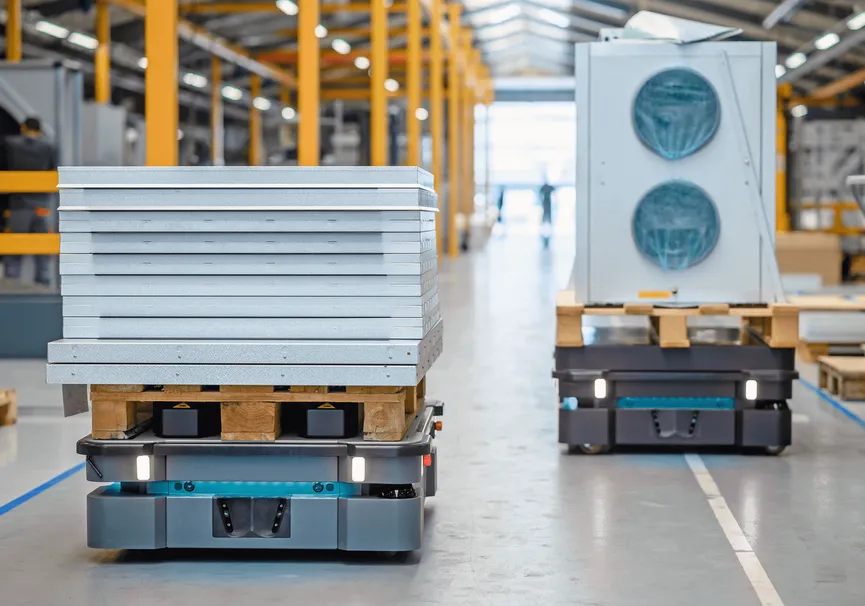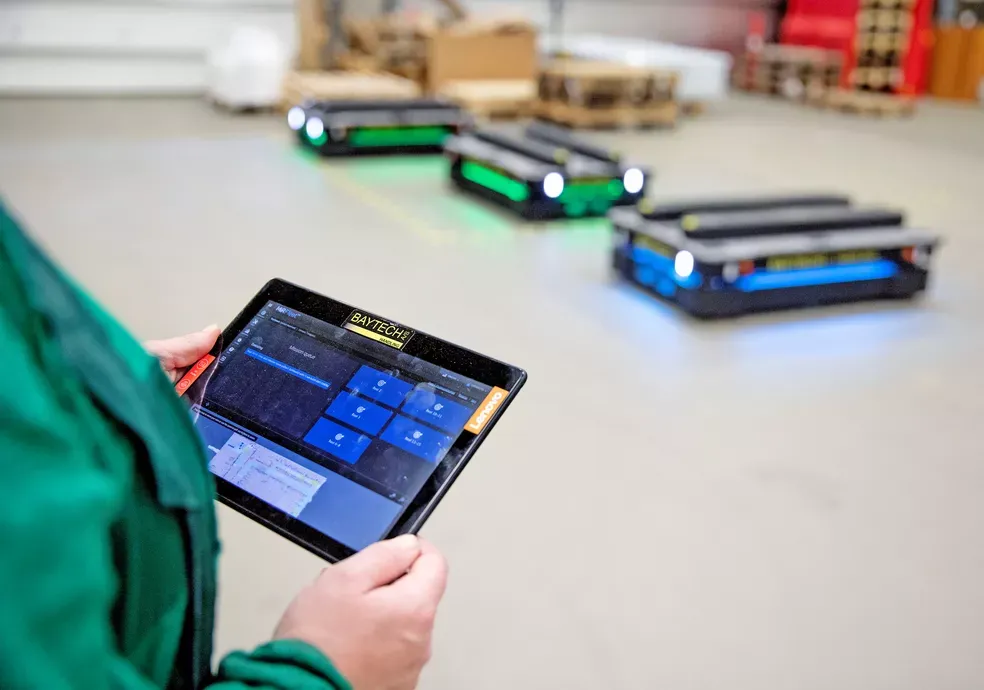Q&A about interoperability of AMRs
Across industries, manufacturers and their warehouse service providers are constantly looking to optimize processes to meet challenges as labor shortage, increasing competition and a requirement for agile production and fast deliveries.
AMR’s have within a few years become an efficient way to automate internal transportation tasks for companies all over the world. As AMR’s become an increasingly recognized technology, manufacturers, warehouses, and distribution facilities get more sophisticated requirements; they need specialized automated support for movement from general AMRs to forklifts and high-reach trucks to Automated Guided Vehicles (AGVs) to receive, store, move and ship items faster and more accurately

In short
What is interoperability for AMRs?
interoperability is the capacity of a central management system to communicate and coordinate with fleet hardware from different vendors in a single source of control and single interface.
Challenges of AMR interoperability
The ownership of the system performance is uncertain. Moreover, it is not clarified how to manage different maps and configurations from different vendors in a third-party system.
What is VDA 5050 and MassRobotics?
The VDA 5050 is the European standard for AGV and AMR interoperability. In contrast, MassRobotics is the American concept for interoperability standards.
The redundancy of existing systems?
The vendor specific robot-software and fleet management software is still evident to ensure the performance of AMRs, and it will be for years ahead.
MiR’s take on interoperability
MiR is certain that interoperability is set to become an increasingly important part of intralogistics because customers want to create their optimal automation solution and manage it from a central point
With growing automation trends and implementation of different AMRs and other automated vehicles, more complex traffic situations arise. The logistics systems are likely to have been sourced from different vendors with varying operating standards and separate control systems. That complexity is not ideal for the end-user looking for ease of use and a single go-to control and support mechanism for the entire fleet of AMRs and automated vehicles.
Therefore, interoperability is a very interesting topic to investigate. Here are five typical questions and MiR’s answers to them.
1. What is interoperability for AMRs?
Current practice sees each AMR vendor using their custom fleet management software, which makes it difficult for end-users to operate a fleet of mixed AMR and AGV brands efficiently. Simply put, interoperability is the capacity of a central management system to communicate and coordinate with fleet hardware from different vendors in a single source of control and single interface and thereby lower the barriers for the further adoption of AMRs.
2. What are the main challenges of AMR interoperability?
Interoperability makes a lot of sense from a customer’s initial perspective because why be tied to a single vendor if the market can be commoditized? But even though the base for interoperability standards has been established today (like MassRobotics and VDA 5050), there is still a long road ahead to fully reap the benefits of interoperability.
Interoperability implies some commercial challenges. The ownership of the system performance is a grey area. Is the third-party fleet manager supplier liable for system glitches or is it the robot manufacturers, even though they did not design the fleet manager but still are providing the data? Or is it the interface that connects to the end-customer’s ERP/WMS system? This is still uncertain.
From a technical point of view, each vendor typically has two types of software; the on-robot software that controls the robot-based planning and the fleet manager-based planning (read more about how MiR’s software works here) and it is not clarified how to manage different maps and configurations etc. from different vendors in a third-party system. Moreover, the data quality of fleet management systems is not standardized, and therefore it can be difficult to clarify, which data that can be exchanged between two AMR systems.

3. What is VDA 5050 and MassRobotics?
The VDA 5050 is a standard on how to communicate between different AGVs, potentially from different vendors, and one control system. The standard describes interfaces and protocols between control layer and AGVs. AMRs can fit into that if they give away some of their autonomy.
The target of this standard is to enable compliant AGVs and mobile robots to work together using one common fleet management software. It describes the communication between two entities; the AGV and the fleet manager, and therefore VDA 5050 will need to be implemented at both ends of the communications channel to function correctly. The intention with VDA 5050 is to control the process on a low level, in contrast to have different vendors doing fleet solutions that could coexist and negotiate on the shop floor.
The VDA 5050 is the European standard for AGV and AMR interoperability. It has been initiated by a collaboration between the German Association of the Automotive Industry (VDA) and the VDMA Material handling and Intralogistics Association. Even though it has been initiated by German associations, it will be used widely across Europe, and possibly across other regions too.
MassRobotics is the American concept for interoperability standards. It is the group’s mission to develop standards to deploy AMRs and other automation equipment from different vendors and have them work together in the same environment. This standard will allow robots of different types to share status information and operational conventions so they can coexist efficiently.
Both VDA 5050 and MassRobotics are at an early stage and the current versions are limited to basic functionalities, like communication of commands to AMR/AGVs and sending actions. They do not yet cover the many other factors that must be managed to ensure a successful multi-robot installation.
4. Do third-party fleet management systems make vendor specific software and fleet management systems redundant?
Interoperability brings many benefits and at some point, third-party fleet management systems can take over the traffic planning and some data exchange but the path towards this is not smooth and we are still at an early stage. The standards are still being tested, and no third-party fleet management systems are able to provide the same fleet management options and same data as e.g. MiR Fleet. As stated, there are many commercial and technical challenges to take into account for interoperability. Therefore, the vendor specific robot-software and fleet management software is still evident to ensure the performance of AMRs, and it will be for years ahead.
In a near future, it is more realistic to see a co-existence between the systems, so AMR manufacturers make interoperability native to their systems, and they can be integrated into a third-party fleet management system or work as third-party management systems that handle the overall traffic control from different AMRs and other automated vehicles. For advanced features, data collection, predictive maintenance, developments etc., state of the art software from the AMR manufacturer is still a key to a successful integration.
5. What is MiR’s take on interoperability?
As a customer-driven organization, MiR fully acknowledges the need for interoperability between different AMRs and AGVs for efficient traffic management across brands. Therefore, MiR has a designated interoperability team, and MiR is involved with VDA 5050 and is part of the MassRobotics AMR Interoperability Working Group.
Moreover, MiR has an open interface, which in its nature can integrate with 3rd party fleet management systems. MiR is part of the project: 5G-Robot - 5G Enabled Autonomous Mobile Robotic Systems, where the company plays an active role in the 5G-Robot project that is a collaboration between University of Aalborg, MiR, Universal Robots, Intelligent Systems, Technicon, Telenor, Nokia, and the industrial end users Novo Nordisk, Grundfos, Danfoss and LEGO. The project is supported by the Danish Innovation Fund and aims to lower the barriers for automating processes with robots. MiR is part of this project to contribute to decreasing complexity of robotics deployments including enabling MiR’s mobile robots to work in third party fleet management systems.
MiR is certain that interoperability is set to become an increasingly important part of intralogistics because customers want to be able to create their optimal automation solution and manage it from a central point, which will lead customers to new standards for automation.
Find your return on investment
Supercharge your manufacturing operations with AMRs. Cut costs, streamline supply chains, enhance safety, minimize downtime, create an attractive workplace, and respond swiftly to market demands.
Calculate your ROI by choosing your robot:

250kg payload

600kg payload

1350kg payload